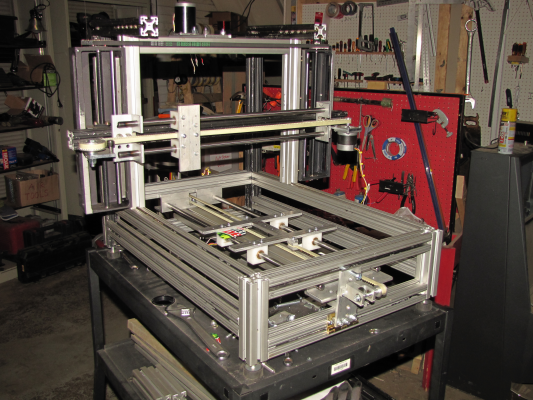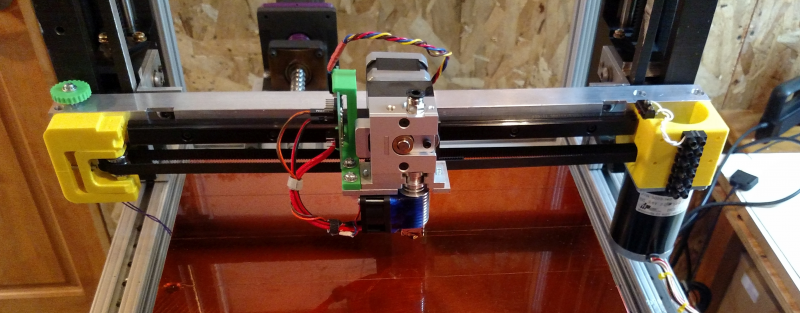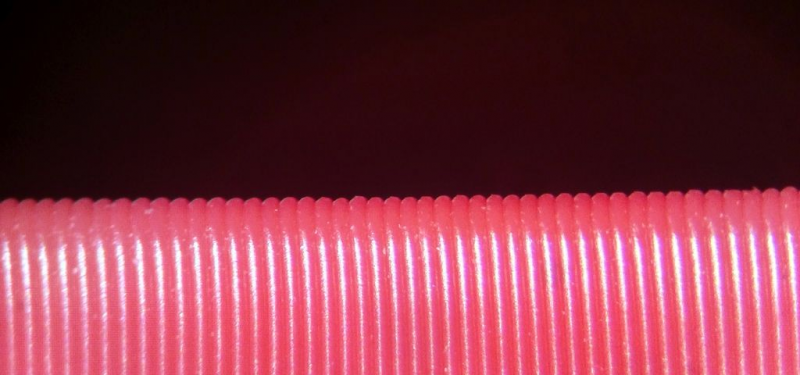CoreXY vs Quadrap mechanism
Posted by the_digital_dentist
|
Re: CoreXY vs Quadrap mechanism December 05, 2015 08:39PM |
Registered: 11 years ago Posts: 1,049 |
????non-linear then you talk about linear ( in line applications) ?????
No belts are easy to use -- sort of like a flexible rack and pinion
Since they are toothed -- positional accuracy can be maintained
Belts are used in many CNC machines like this:
[www.shapeoko.com]
[s3files.core77.com]
[www.inventables.com]
[www.tool-rank.com]

A timing belt pulley is easy to CAD and 3D print. How large of a pulley are you using?
No belts are easy to use -- sort of like a flexible rack and pinion
Since they are toothed -- positional accuracy can be maintained
Belts are used in many CNC machines like this:
[www.shapeoko.com]
[s3files.core77.com]
[www.inventables.com]
[www.tool-rank.com]

A timing belt pulley is easy to CAD and 3D print. How large of a pulley are you using?
Quote
realthor
Belts are difficult to use in non-linear devices like the one I linked to because it's difficult to engage a toothed pulley that sits in between to segments of straight line. One would have to insert two additional pulleys that would force the belt go around as many teeth as possible around the large pulley, something like this. Also having such a large pulley like in my design is quite difficult to have it machined. The closest I can think of is glue a belt around it so the other belt has something to engage to.
|
Re: CoreXY vs Quadrap mechanism December 05, 2015 11:04PM |
Registered: 9 years ago Posts: 1,035 |
@CozmicRay:
@patrickrio:
Is there anything that can be done for linear rods-based CoreXY to improve parallelism? I am designing my Y carriages myself so I am thinking that maybe my lack of experience will get me to miss something that could otherwise improve my design or make it perform as expected. I see a lot of Corexy designs that are pretty simple, with Y carriages sliding on rods via 2 linear bearings while they have two clamps for the X rods. I don't think one can do it otherwise with rods. Maybe use all-metal/machined carriages for best thermal/wear stability and long life.
I am also thinking of using bushings, maybe the exact igus bushings that one of the machines in the first posts examples is using because bushings have (i might be wrong) better tolerances than linear bearings, at least better than cheap linear bearings. Maybe if compared with same-priced linear bearings (igus DryLin® R - RJ4JP 01-10 goes for Eur4 a pop on amazon.de). But still 10mm linear rods + such expensive bearings are cheaper than similar linear steel rail. I am talking about new ones, I didn't find SH ones around.
Linear bushings are described by Mitsumi as the lower-end cousing of Linear Guides. I thought that they were right there at the top but apparently I was wrong. I guess round shaft is somewhere in the "amateurish" drawer of serious engineering while the former are the de-facto solutions for linear movement. I just don't see such expensive motion systems to make much sense at least in non-commercial 3D printing. Not that I wouldn' like to use them or have them but for most is just like buying a best in class TV and watching from a distance where the pixel density of HD can't really be observed anymore.
Edited 4 time(s). Last edit at 12/05/2015 11:30PM by realthor.
RepRap Lander concept on Concept Forge
RepRap Lander concept on RepRap Forums
My Things, mostly experimental stuff
Quote
realthor
Belts are difficult to use in non-linear devices like the one I linked.
@patrickrio:
Quote
patrickrio
The whole point of the discussion is to bring attention to the "gotchas" of installation - and parallel is the biggest gotcha I see for CoreXY when using linear guides. Maybe it is not that big of a gotcha, but I think it may be the biggest one. Adding lips to a design may not cost much, and pretty much eliminates (or at least reduces substantially) all facets of the problem as it exists in the CoreXY mechanism.
Is there anything that can be done for linear rods-based CoreXY to improve parallelism? I am designing my Y carriages myself so I am thinking that maybe my lack of experience will get me to miss something that could otherwise improve my design or make it perform as expected. I see a lot of Corexy designs that are pretty simple, with Y carriages sliding on rods via 2 linear bearings while they have two clamps for the X rods. I don't think one can do it otherwise with rods. Maybe use all-metal/machined carriages for best thermal/wear stability and long life.
I am also thinking of using bushings, maybe the exact igus bushings that one of the machines in the first posts examples is using because bushings have (i might be wrong) better tolerances than linear bearings, at least better than cheap linear bearings. Maybe if compared with same-priced linear bearings (igus DryLin® R - RJ4JP 01-10 goes for Eur4 a pop on amazon.de). But still 10mm linear rods + such expensive bearings are cheaper than similar linear steel rail. I am talking about new ones, I didn't find SH ones around.
Linear bushings are described by Mitsumi as the lower-end cousing of Linear Guides. I thought that they were right there at the top but apparently I was wrong. I guess round shaft is somewhere in the "amateurish" drawer of serious engineering while the former are the de-facto solutions for linear movement. I just don't see such expensive motion systems to make much sense at least in non-commercial 3D printing. Not that I wouldn' like to use them or have them but for most is just like buying a best in class TV and watching from a distance where the pixel density of HD can't really be observed anymore.
Edited 4 time(s). Last edit at 12/05/2015 11:30PM by realthor.
RepRap Lander concept on Concept Forge
RepRap Lander concept on RepRap Forums
My Things, mostly experimental stuff
|
Re: CoreXY vs Quadrap mechanism December 06, 2015 12:36AM |
Registered: 11 years ago Posts: 5,780 |
Misumi's first sentance says it all: "If you need a quick and easy way to facilitate a linear motion profile, the linear bushing is a great choice, especially if you don’t have high tolerance or accuracy requirements. "
I consider a 3D printer to be a mechanism that requires high accuracy and precision (i.e. tight tolerances), which rules out bushings. Every bushing I've ever seen wiggles on the rail. You can double them up to get more stability, but that increases size. Having to use two round rails increases size/mass, too. I started with brass bushings in my printer a few years ago and quickly replaced them with linear bearings. I finally replaced all that stuff with linear guides about a year ago.
My X axis went from this ugly mess (two 1/2" rails with brass bushings):
to this (one linear guide mounted on a 1" square tube):
If you want high quality output from the printer, the design and parts used to make it also have to be high quality. Look at your prints and be very critical (I like to examine mine under a microscope). How does your print differ from the CAD design? Did the CAD design have those ripples in the surface? Was it perfectly round? Is your print? Are the layers laid on top of each other precisely? Do printed gears fit together and turn against each other without binding? Try to understand how the defects are created and what can be done about them. With FDM printing, most defects can be fixed with quality construction and components, including guides/bearings.
This is what sturdy construction and quality bearings/guides can do:
That's the corner of a calibration cube printed in 250 um layers.
Linear guides don't have to be expensive. Search for "linear guide" on ebay and you'll find at least 10 pages of listings. I recently picked up a new-old-stock 630 mm long IKO linear guide with bearing block for $34 shipped. There's a dealer in Korea who sells hundreds of the things for very good prices, shipping anywhere in the world included. Another in Canada whose listings show photos of what has to be thousands of linear guides and lead screws.
Regardless of architecture, it will probably cost more than $300 to build a machine with a rigid frame and quality guides/bearings and electronics. Quality costs. It always has and always will, because it's worth more.
Edited 4 time(s). Last edit at 12/06/2015 12:58AM by the_digital_dentist.
Ultra MegaMax Dominator 3D printer: [drmrehorst.blogspot.com]
I consider a 3D printer to be a mechanism that requires high accuracy and precision (i.e. tight tolerances), which rules out bushings. Every bushing I've ever seen wiggles on the rail. You can double them up to get more stability, but that increases size. Having to use two round rails increases size/mass, too. I started with brass bushings in my printer a few years ago and quickly replaced them with linear bearings. I finally replaced all that stuff with linear guides about a year ago.
My X axis went from this ugly mess (two 1/2" rails with brass bushings):
to this (one linear guide mounted on a 1" square tube):
If you want high quality output from the printer, the design and parts used to make it also have to be high quality. Look at your prints and be very critical (I like to examine mine under a microscope). How does your print differ from the CAD design? Did the CAD design have those ripples in the surface? Was it perfectly round? Is your print? Are the layers laid on top of each other precisely? Do printed gears fit together and turn against each other without binding? Try to understand how the defects are created and what can be done about them. With FDM printing, most defects can be fixed with quality construction and components, including guides/bearings.
This is what sturdy construction and quality bearings/guides can do:
That's the corner of a calibration cube printed in 250 um layers.
Linear guides don't have to be expensive. Search for "linear guide" on ebay and you'll find at least 10 pages of listings. I recently picked up a new-old-stock 630 mm long IKO linear guide with bearing block for $34 shipped. There's a dealer in Korea who sells hundreds of the things for very good prices, shipping anywhere in the world included. Another in Canada whose listings show photos of what has to be thousands of linear guides and lead screws.
Regardless of architecture, it will probably cost more than $300 to build a machine with a rigid frame and quality guides/bearings and electronics. Quality costs. It always has and always will, because it's worth more.
Edited 4 time(s). Last edit at 12/06/2015 12:58AM by the_digital_dentist.
Ultra MegaMax Dominator 3D printer: [drmrehorst.blogspot.com]
|
Re: CoreXY vs Quadrap mechanism December 06, 2015 02:35AM |
Registered: 9 years ago Posts: 1,035 |
Quote
the_digital_dentist
Misumi's first sentance says it all: "If you need a quick and easy way to facilitate a linear motion profile, the linear bushing is a great choice, especially if you don’t have high tolerance or accuracy requirements. "
They also say "However, these errors are typically small, on the order of a few thousandths of an inch. The setup and maintenance are also very inexpensive compared to other options.' Aren't these tolerances well within what we use in 3D printing?
Moreover, IGUS dry-lin, the bushings I have mentioned, document the offered tolerances and the way their bushings have to be installed to maintain precision. Bushings seem to be adequate for loads that fall within their documented values. Of course linear ball-bearings are very good and offer a much higher upper load limit. I understand that finding cheap linear rail is way better than buying smooth rod for both weight (haven't check if one linear rail is lighter than two smooth rods of same length) and complexity issues regarding parallel installation but they are much more than needed for many carriages (bowden take the load off the carriage, allowing higher speeds, necessary in prototyping applications). Also bushings offer the noise reduction that many require for consumer-grade appliances that we keep in our homes.
At the end of the day, you seem to have a garage/workshop where you do the 3d printing, many of us have some room just next to us. That allows you to have industrial-grade equipment and can go overkill to whatever lengths you please. For me engineering is also about using least amount of material/etc for the needed task, and that's why bushings seem such a good fit. I calculate my carriage weight and size my other components accordingly. I would even use hollow linear tubing if they would be available with the tolerances offered by smooth rods.
In the first posts regarding the quadrap mechanism there were youtube links to machines that used hollow tubes for movement. I get it that they were only examples but I find it appropriate to the task, should the linear tubes be really "linear". But I only know of "linear" aluminum extrusions (T/V-slot profile) or this type of sliding linear rail that can be used as a light-weight alternative to steel shafts or steel rail. Personally my view is that the industry wasn't quite prepared for lightweight applications like FFF and all we use now, or the vast majority are retrofitted industrial standards from the CNC industry. There might be lighter weight linear options but because they are niche, they were too expensive to retrofit.
RepRap Lander concept on Concept Forge
RepRap Lander concept on RepRap Forums
My Things, mostly experimental stuff
|
Re: CoreXY vs Quadrap mechanism December 06, 2015 10:15AM |
Registered: 11 years ago Posts: 5,780 |
A few thousandths of an inch is about 75 um, which is about the thickness of a piece of paper, which is about 1/3 the thickness of a typical 3D print layer. Is that within the tolerance of a typical 3D printer? Let's see...
If you have that error in just the Z axis, your layer thickness will vary, causing Z banding in the prints, possibly making it difficult to get parts to stick to the bed reliably, even if the bed is flat and level. So you'll use auto leveling to ensure the first layer sticks. But if the position of Z=0 isn't located precisely, and the bed isn't actually flat (autoleveling assumes it is) autoleveling may not work well. If you have that error in just the Y axis or X axis, layer registration may be off, producing Z banding and making close tolerance parts hard to fit together, and waves, ripple, or other textures may appear in the surface of the prints.
Now imagine all three of those errors at once. Now compound those errors with flex in the machine's frame. How reliable is your printer going to be and what will the prints look like? Yes, I'd say all that sounds about right for the tolerances found in typical 3D printers, judging by the prints I've seen.
How long are bushings going to last when they slide along the rails as much as they do in a 3D printer? What's going to happen to print quality as the bushings wear? One of the big reasons to use ball bushings or linear guides is to reduce degradation in print quality due to wear in the mechanism.
Plastic bushings are usually pretty quiet, at least until they wear and start to chatter. Linear guides and ball bushings do make a little of that steel-balls-rolling-on-steel-rails noise, but it's usually masked by the noise from fans and noise created by vibrations in the drive motors.
Ultra MegaMax Dominator 3D printer: [drmrehorst.blogspot.com]
If you have that error in just the Z axis, your layer thickness will vary, causing Z banding in the prints, possibly making it difficult to get parts to stick to the bed reliably, even if the bed is flat and level. So you'll use auto leveling to ensure the first layer sticks. But if the position of Z=0 isn't located precisely, and the bed isn't actually flat (autoleveling assumes it is) autoleveling may not work well. If you have that error in just the Y axis or X axis, layer registration may be off, producing Z banding and making close tolerance parts hard to fit together, and waves, ripple, or other textures may appear in the surface of the prints.
Now imagine all three of those errors at once. Now compound those errors with flex in the machine's frame. How reliable is your printer going to be and what will the prints look like? Yes, I'd say all that sounds about right for the tolerances found in typical 3D printers, judging by the prints I've seen.
How long are bushings going to last when they slide along the rails as much as they do in a 3D printer? What's going to happen to print quality as the bushings wear? One of the big reasons to use ball bushings or linear guides is to reduce degradation in print quality due to wear in the mechanism.
Plastic bushings are usually pretty quiet, at least until they wear and start to chatter. Linear guides and ball bushings do make a little of that steel-balls-rolling-on-steel-rails noise, but it's usually masked by the noise from fans and noise created by vibrations in the drive motors.
Ultra MegaMax Dominator 3D printer: [drmrehorst.blogspot.com]
Sorry, only registered users may post in this forum.



